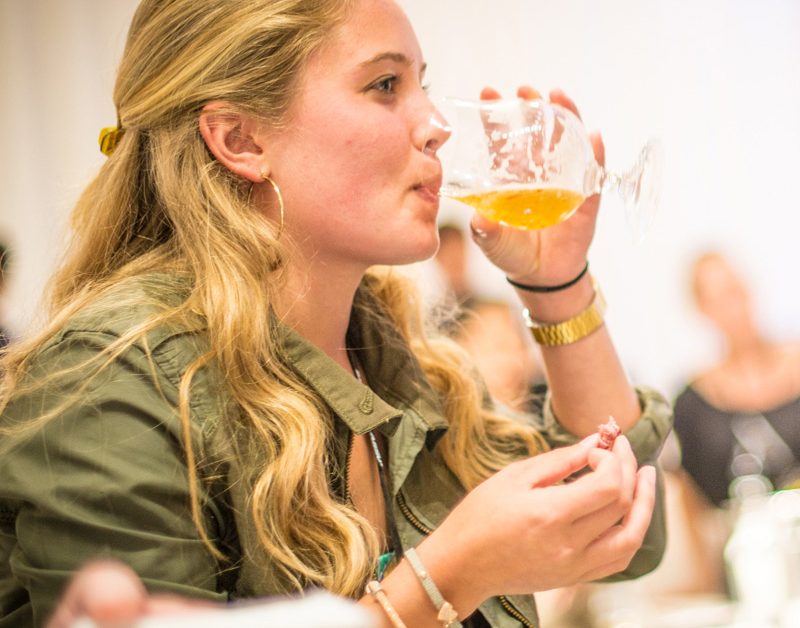Through trial and error in the last seven years, I’ve put together a graphic to chew on (pun intended) that I call my Craft Beer Characteristics Chart. To me, this not only provides pairing terms, but helps visually unscramble the web of interactions and flavors that happen when paring craft beer and food.
Now to many, the characteristics chart (below) might look like an information graphic gone spider ballistic, but bear with me while I explain. When approaching pairing, I’ve found the most success by first getting a true understanding of all the characteristics (taste elements, flavors, intensity and sensations) of the craft beer I plan to pair with.
By accounting for each of these four characteristics in a craft beer, I have the best chance to dial in on what might harmonize or clash with the food I’m pairing to. Said another way, think of craft beer as an ingredient and use the characteristics chart as a road map to identify what elements are present. This gives you a better chance of identifying how a specific craft beer might interact with different foods.
Craft Beer Characteristics Chart
Download the Characteristics ChartOpens in new window
 Opens in new window
Opens in new window
Taste Elements
The dominant craft beer taste elements will contrast against the food’s taste elements, so that the beer and food flavors shine.
- Sweet calms sweet (allowing other flavors rise to the surface). Examples: peas and carrots; milk and cookies; stout and vanilla ice cream floats.
- Acidic calms salt (acid cuts the salt and balances flavor to create a “cleanness”). Examples: ceviche and tortilla chips; tomatoes and mozzarella cheese; pickles and a corned beef sandwich.
- Bitter calms sweet (allowing other flavors rise to the surface). Example: the sweet of malted barley is calmed and balanced by the bitterness of hop alpha acids. Think: An India pale ale’s bitterness calms the sweetness of the icing on a carrot cake.
- Umami complements umami. Examples: mushrooms on fettuccine alfredo; parmesan cheese on spaghetti and meatballs; an aged old ale and holiday fruitcake.
Flavors
Look for flavor bridges, where the flavors of craft beer can bridge to the flavors in a food dish. This helps create harmonies, home runs and the complementing interactions we all enjoy.
Below you’ll find examples of flavor groups. Look for commonalities within a group, as they will be helpful in choosing pairings. Example: a porter with hints of vanilla and chocolate can complement a brown sugar caramel cake.
This list represents a tiny sampling of common flavor groups, offering a suggested pairing to help make the connections.
- Group: Rosemary, juniper, pine, spruce Pairing: American pale ale and rosemary-dusted creamed chicken
- Group: Brown sugar, butter, caramel, maple syrup, vanilla, coconut, toffee Pairing: English-style barley wine and blonde brownie with butterscotch sauce
- Group: Mint, dill, basil, endive, coriander, fennel, parsley, lemongrass, bay leaves, oregano Pairing: Belgian-style saison and white fish with lemon and dill
- Group: Cinnamon, cumin, pepper, cardamom, ginger, clove Pairing: Ginger porter with Moroccan clove and ginger beef shish kebabs
- Group: Date, fig, raisin Pairing: Belgian-style strong dark ale and bacon wrapped dates
- Group: Pineapple, tangerine, clementine Pairing: American-style India pale ale and orange chicken stir fry
- Group: Mango, papaya, guava, lychee, banana Pairing: Wild ale with mango pineapple salsa and chips
- Group: Strawberry, raspberry, blackberry, cranberry, pomegranate, currant Pairing: Raspberry wheat ale and salad with dried cranberries and a raspberry vinaigrette
- Group: Chocolate, truffle, cocoa powder Pairing: Milk stout and double chocolate cake
Intensity
Craft beer and food pairings are most successful when the intensity of the beer matches that of the dish. You don’t want the craft beer to outweigh the food and vice versa.
Sensations
Sensations cause rests or palate resets and can even calm/cut through food’s oils, creams and fats.
 Helpful Pairing Terms
Helpful Pairing Terms
Download the Potential Interactions Chart
- Complement: When one item from a craft beer or food complements the other during pairing.
- Counter/Contrast: When elements interact and either heighten or calm each other’s intensities. Malty sweetness counters the sugar sweet of a food and lessens the sweetness.
- Cut: The bitterness of hops cut and lessen the impact of fat, richness and oil in food. This allows you to more easily identify flavors and taste elements. Cutting also occurs from carbonation and acidity.
- Home run: When a craft beer and food pairing elevates the taste experience. The whole is better than the individual parts. 1 + 1 = 3!
- Train wreck: A clash of elements or flavors from the meeting of food or craft beer. A train wreck is when the whole tastes less desirable than the individual parts. 1 + 1 = -1. Think orange juice and toothpaste. Yuck!
- Rest: When your craft beer or food ingredients provide a break and help renew and reset your palate. A rest can be an intermezzo in the middle of the meal.
- Bridge: Where craft beer and food meet ingredient to ingredient. Bridges help you find harmonies, also referred to as flavor hooks.
- Echo: When one flavor, sensation or intensity repeats the other. These create more pairing harmonies.
- Harmony: A synergistic marriage of flavor and taste elements.
Addendum 8/9/13: Want to learn more? I strongly encourage expanding one’s beer journey by exposure to the many resources available today including: Beer Schools, BA Beer Style GuidelinesOpens in new window, and the many amazing beer books available.
CraftBeer.com is fully dedicated to small and independent U.S. breweries. We are published by the Brewers Association, the not-for-profit trade group dedicated to promoting and protecting America’s small and independent craft brewers. Stories and opinions shared on CraftBeer.com do not imply endorsement by or positions taken by the Brewers Association or its members.


Share Post